Abstract
The effects of edrophonium and choline have been compared with those of the depolarizing substances acetylcholine, decamethonium, and suxamethonium, in both innervated and chronically denervated tibialis anterior muscles of cats under chloralose anaesthesia. Both edrophonium and choline were more potent antagonists to paralysis by tubocurarine than could be accounted for by their ability to stimulate the motor end-plates directly. It appeared likely that direct depolarization of the end-plate played no part in the anti-curare action of edrophonium and only some part in the anti-curare action of choline. A paralysis produced by the neuromuscular blocking agent, benzoquinonium, was more readily antagonized by a tetanus or by acetylcholine, suxamethonium, and decamethonium than a similar paralysis produced by tubocurarine. The tetraethyl ammonium ion was also slightly more effective against a paralysis by benzoquinonium. On the other hand, edrophonium was about 300 times and choline about five times less potent as an antagonist to benzoquinonium than to tubocurarine. Furthermore, the previous administration of benzoquinonium abolished the antagonistic action to tubocurarine of normally effective doses of edrophonium and reduced that of choline. These results were similar to those previously obtained with neostigmine, physostigmine and ethyl pyrophosphate and suggested that there was some similarity in the mechanism of action of all of these substances. Benzoquinonium, therefore, showed promise as a useful pharmacological tool for distinguishing compounds with this particular type of action. These anti-curare compounds did not appear to act by cholinesterase inhibition, not by an increase in the sensitivity of the motor end-plates. In common with other workers, we suggest that there is a pre-synaptic mechanism of action.
Full text
PDF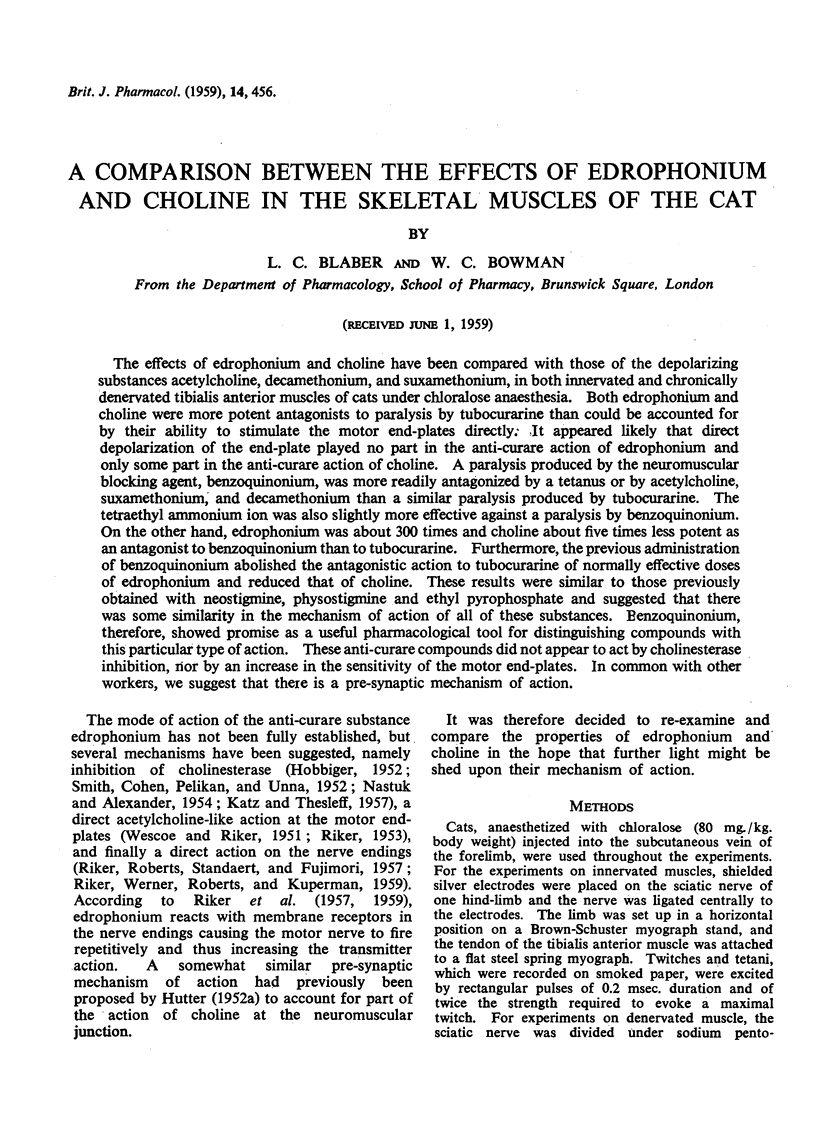



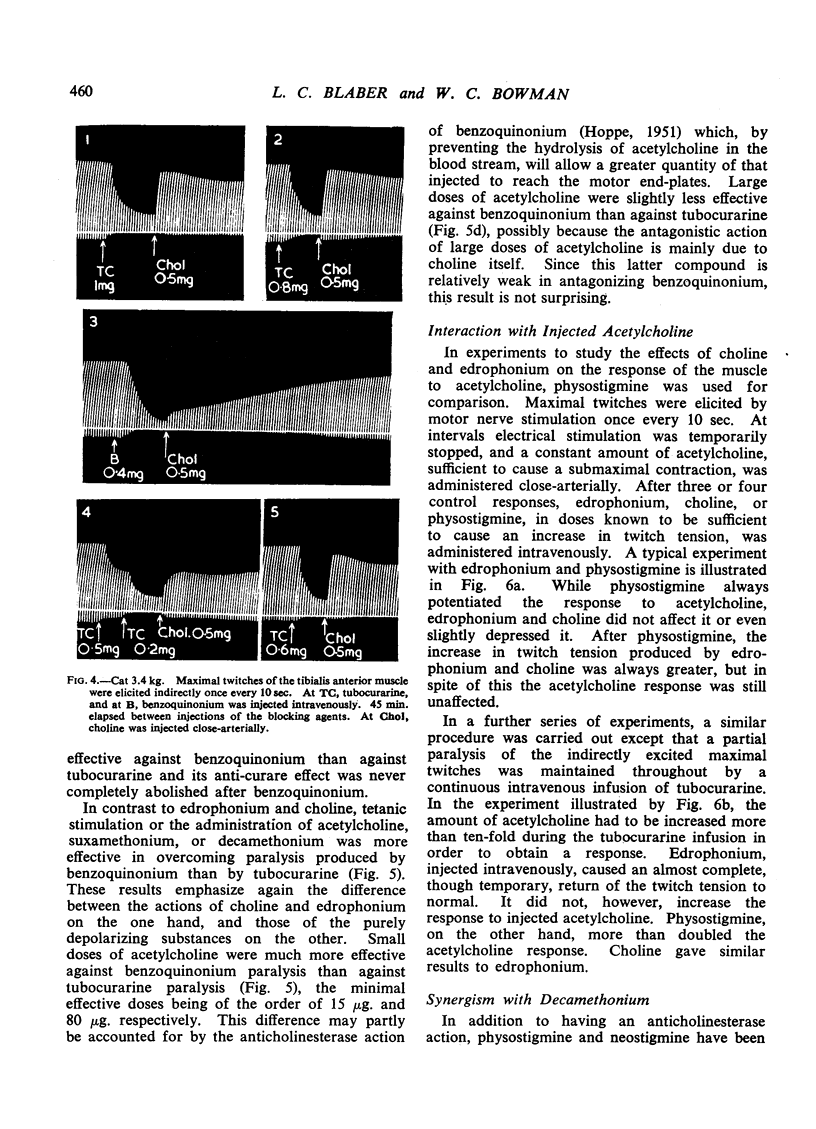


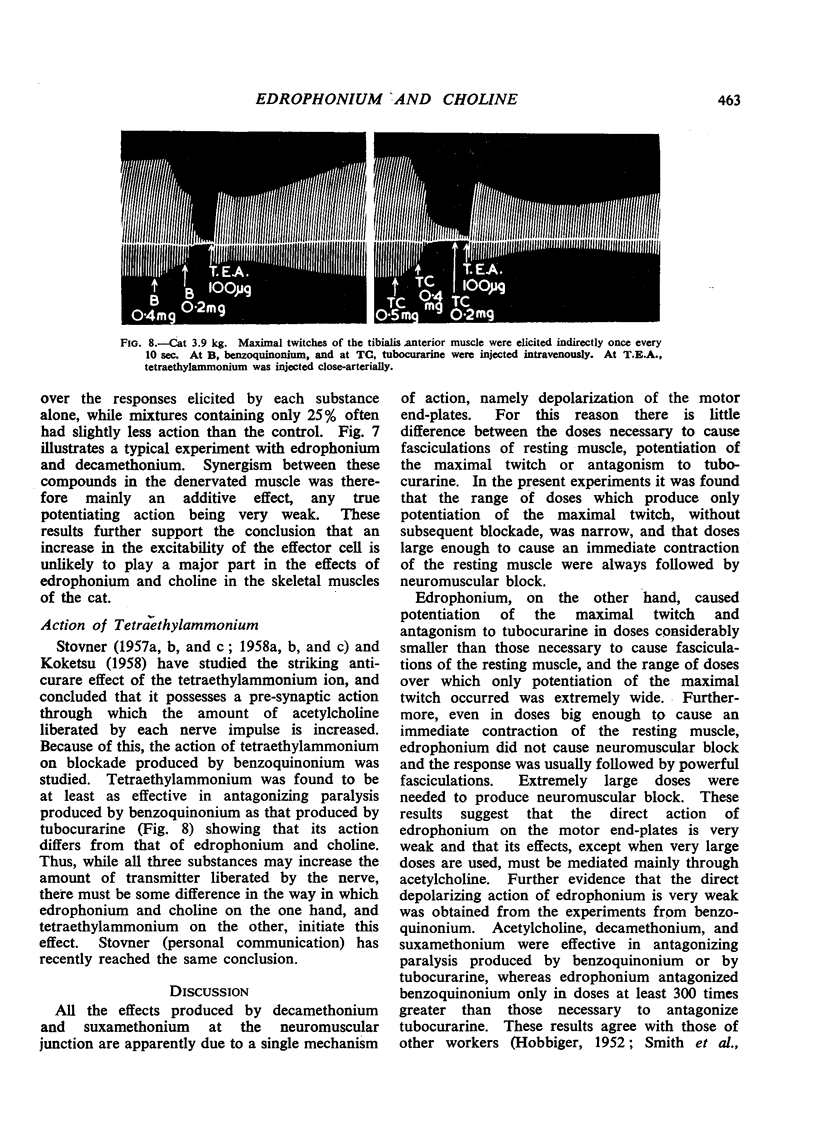
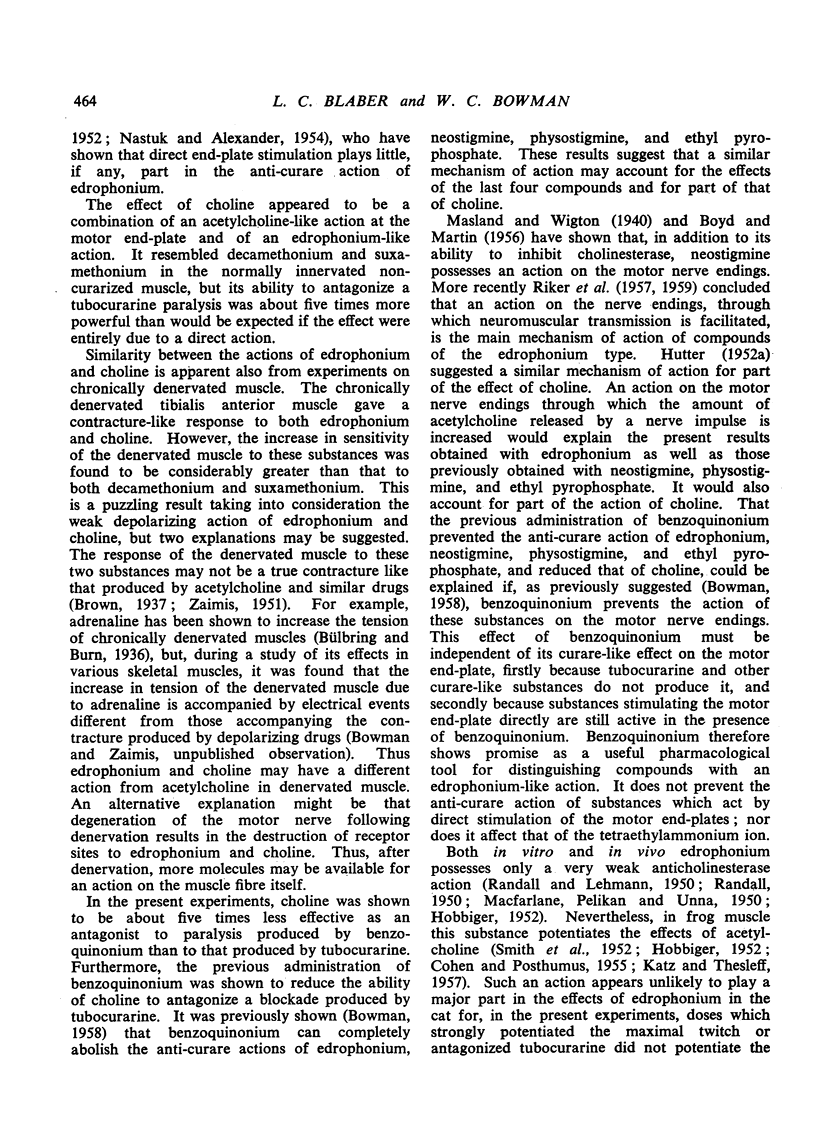
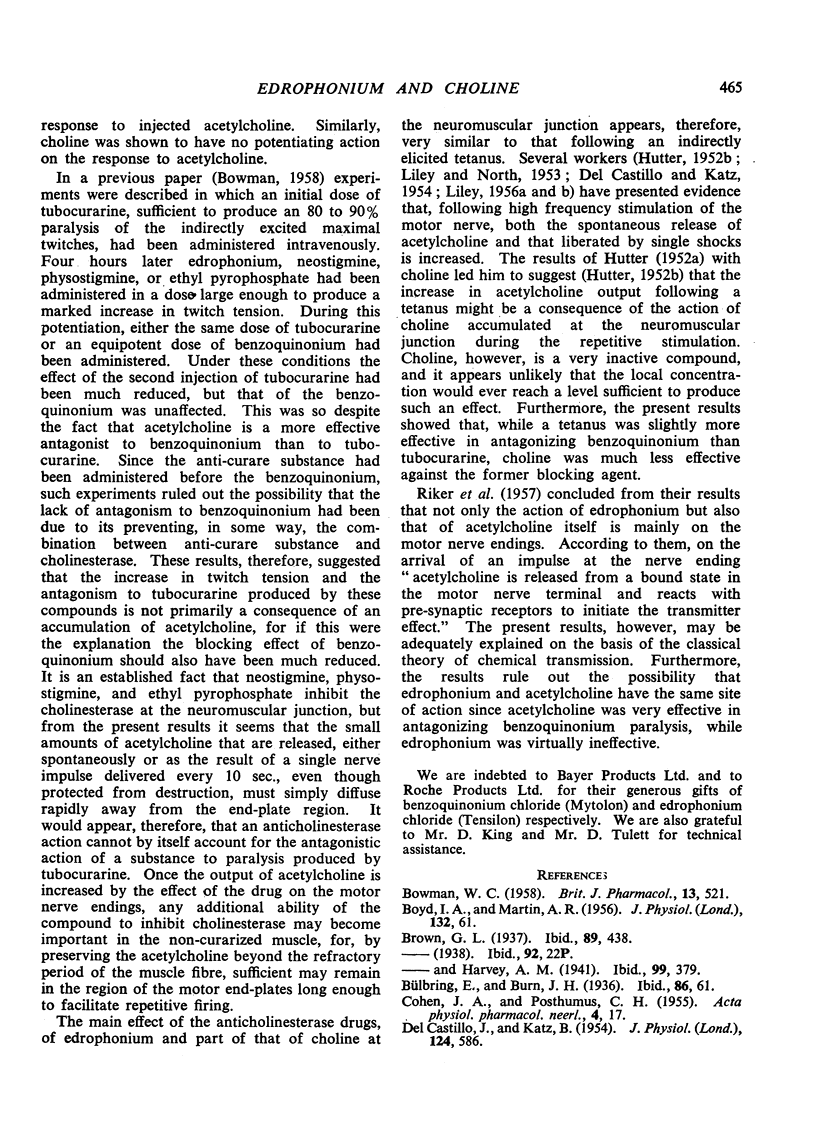
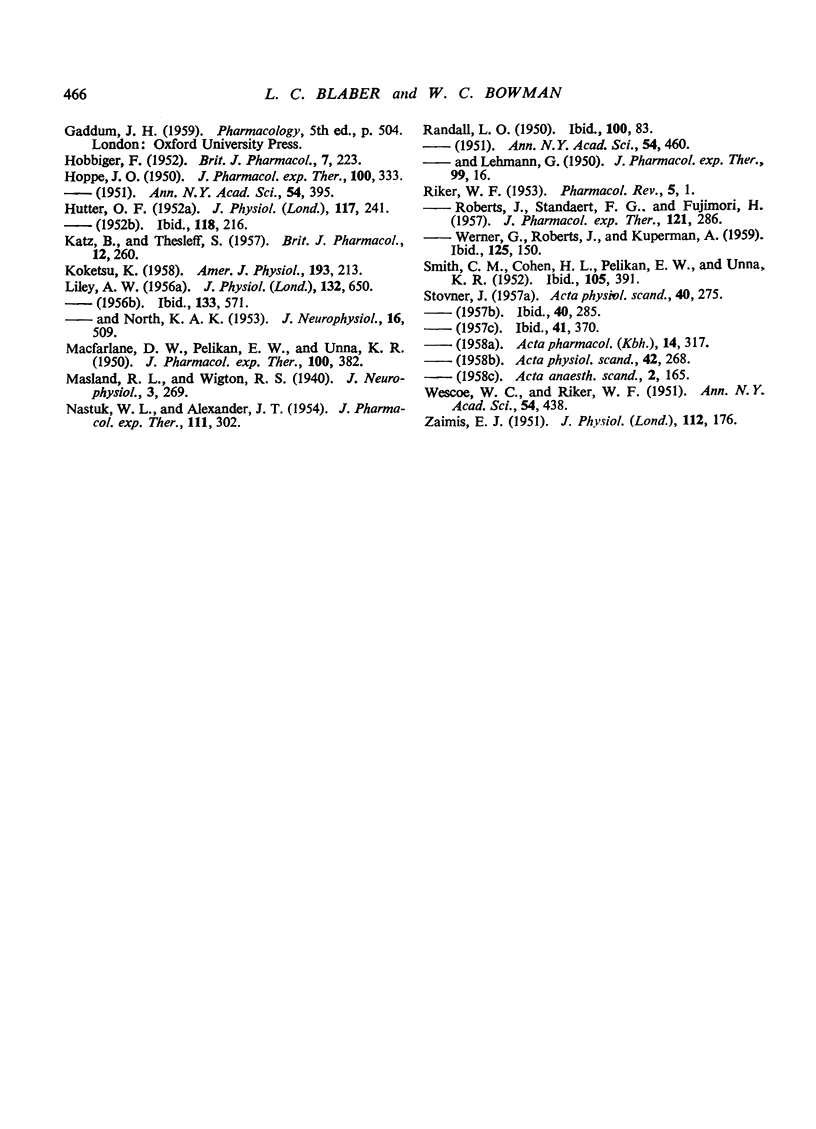
Selected References
These references are in PubMed. This may not be the complete list of references from this article.
- BOYD I. A., MARTIN A. R. Spontaneous subthreshold activity at mammalian neural muscular junctions. J Physiol. 1956 Apr 27;132(1):61–73. doi: 10.1113/jphysiol.1956.sp005502. [DOI] [PMC free article] [PubMed] [Google Scholar]
- Brown G. L., Harvey A. M. Neuro-muscular transmission in the extrinsic muscles of the eye. J Physiol. 1941 Mar 25;99(3):379–399. doi: 10.1113/jphysiol.1941.sp003910. [DOI] [PMC free article] [PubMed] [Google Scholar]
- Brown G. L. The actions of acetylcholine on denervated mammalian and frog's muscle. J Physiol. 1937 Jun 3;89(4):438–461. doi: 10.1113/jphysiol.1937.sp003491. [DOI] [PMC free article] [PubMed] [Google Scholar]
- Bülbring E., Burn J. H. The Sherrington phenomenon. J Physiol. 1936 Jan 15;86(1):61–76. doi: 10.1113/jphysiol.1936.sp003343. [DOI] [PMC free article] [PubMed] [Google Scholar]
- DEL CASTILLO J., KATZ B. Changes in end-plate activity produced by presynaptic polarization. J Physiol. 1954 Jun 28;124(3):586–604. doi: 10.1113/jphysiol.1954.sp005131. [DOI] [PMC free article] [PubMed] [Google Scholar]
- HOBBIGER F. The mechanism of anticurare action of certain neostigmine analogues. Br J Pharmacol Chemother. 1952 Jun;7(2):223–236. doi: 10.1111/j.1476-5381.1952.tb01317.x. [DOI] [PMC free article] [PubMed] [Google Scholar]
- HOPPE J. O. A pharmacological investigation of 2,5-bis-(3-diethylaminopropylamino) benzoquinone-bis-benzylchloride (WIN 2747): a new curarimimetic drug. J Pharmacol Exp Ther. 1950 Nov;100(3):333–345. [PubMed] [Google Scholar]
- HUTTER O. F. Effect of choline on neuromuscular transmission in the cat. J Physiol. 1952 Jun;117(2):241–250. doi: 10.1113/jphysiol.1952.sp004744. [DOI] [PMC free article] [PubMed] [Google Scholar]
- KATZ B., THESLEFF S. The interaction between edrophonium (tensilon) and acetylcholine at the motor end-plate. Br J Pharmacol Chemother. 1957 Jun;12(2):260–264. doi: 10.1111/j.1476-5381.1957.tb00131.x. [DOI] [PMC free article] [PubMed] [Google Scholar]
- KOKETSU K. Action of tetraethylammonium chloride on neuromuscular transmission in frogs. Am J Physiol. 1958 Apr;193(1):213–218. doi: 10.1152/ajplegacy.1958.193.1.213. [DOI] [PubMed] [Google Scholar]
- LILEY A. W. An investigation of spontaneous activity at the neuromuscular junction of the rat. J Physiol. 1956 Jun 28;132(3):650–666. doi: 10.1113/jphysiol.1956.sp005555. [DOI] [PMC free article] [PubMed] [Google Scholar]
- LILEY A. W., NORTH K. A. An electrical investigation of effects of repetitive stimulation on mammalian neuromuscular junction. J Neurophysiol. 1953 Sep;16(5):509–527. doi: 10.1152/jn.1953.16.5.509. [DOI] [PubMed] [Google Scholar]
- MacFARLANE D. W., PELIKAN E. W., UNNA K. R. Evaluation of curarizing drugs in man. V. Antagonism to curarizing effects of d-tubocurarine by neostigmine, m-hydroxy phenyltrimethylammonium and m-hydroxy phenylethyldimethylammonium. J Pharmacol Exp Ther. 1950 Nov;100(3):382–392. [PubMed] [Google Scholar]
- NASTUK W. L., ALEXANDER J. T. The action of 3-hydroxyphenyldimethylethyl-ammonium (tensilon) on neuromuscular transmission in the frog. J Pharmacol Exp Ther. 1954 Jul;111(3):302–328. [PubMed] [Google Scholar]
- RANDALL L. O. Anticurare action of phenolic quaternary ammonium salts. J Pharmacol Exp Ther. 1950 Sep;100(1):83–93. [PubMed] [Google Scholar]
- RIKER W. F., Jr Exicitatory and anticurare properties of acetylcholine and related quaternary ammonium compounds at the neuromuscular junction. Pharmacol Rev. 1953 Mar;5(1):1–86. [PubMed] [Google Scholar]
- RIKER W. F., Jr, ROBERTS J., STANDAERT F. G., FUJIMORI H. The motor nerve terminal as the primary focus for drug-in-duced facilitation of neuromuscular transmission. J Pharmacol Exp Ther. 1957 Nov;121(3):286–312. [PubMed] [Google Scholar]
- RIKER W. F., Jr, WERNER G., ROBERTS J., KUPERMAN A. Pharmacologic evidence for the existence of a presynaptic event in neuromuscular transmission. J Pharmacol Exp Ther. 1959 Feb;125(2):150–158. [PubMed] [Google Scholar]
- SMITH C. M., COHEN H. L., PELIKAN E. W., UNNA K. R. Mode of action of antagonists to curare. J Pharmacol Exp Ther. 1952 Aug;105(4):391–399. [PubMed] [Google Scholar]
- STOVNER J. The action of tetraethylammonium (TEA) on the rat diaphragm. Acta Physiol Scand. 1957 Oct 10;40(2-3):275–284. doi: 10.1111/j.1748-1716.1957.tb01496.x. [DOI] [PubMed] [Google Scholar]
- WESCOE W. C., RIKER W. F., Jr The pharmacology of anti-curare agents. Ann N Y Acad Sci. 1951 Oct;54(3):438–459. doi: 10.1111/j.1749-6632.1951.tb39935.x. [DOI] [PubMed] [Google Scholar]
- ZAIMIS E. J. The action of decamethonium on normal and denervated mammalian muscle. J Physiol. 1951 Jan;112(1-2):176–190. doi: 10.1113/jphysiol.1951.sp004518. [DOI] [PMC free article] [PubMed] [Google Scholar]


